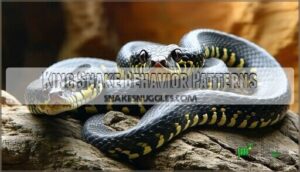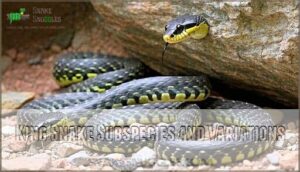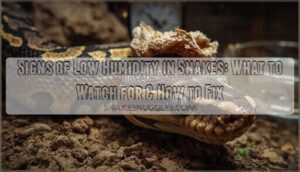This site is supported by our readers. We may earn a commission, at no cost to you, if you purchase through links.
 King snake species for beginners offer excellent starter reptiles with manageable care requirements.
King snake species for beginners offer excellent starter reptiles with manageable care requirements.
You’ll find California kingsnakes and Eastern kingsnakes are the most beginner-friendly options, featuring docile temperaments and straightforward housing needs.
These non-venomous constrictors typically reach 3-5 feet in length and adapt well to captivity.
California kings display striking black and white banding patterns, while Eastern kings showcase glossy black scales with white chain-like markings.
Both species tolerate handling well once acclimated and require basic setups with proper heating, humidity control, and secure enclosures.
Their hardy nature makes them forgiving of minor care mistakes that new snake owners often make, and they are non-venomous constrictors with manageable care requirements, making them ideal for those who want straightforward housing needs.
Table Of Contents
- Key Takeaways
- Choosing King Snakes
- King Snake Care Basics
- King Snake Behavior Patterns
- King Snake Species Overview
- King Snake Health Considerations
- King Snake Cost and Legality
- Frequently Asked Questions (FAQs)
- What is the best king snake for beginners?
- What is the most beginner friendly snake?
- What is the best setup for a king snake?
- What is the best pet snake for a first time owner?
- Do king snakes require special lighting setups?
- Can king snakes be housed together safely?
- How often do king snakes shed skin?
- What substrates work best for king snakes?
- Are king snakes escape artists or climbers?
- Conclusion
Key Takeaways
- You’ll find California and Eastern kingsnakes are the most beginner-friendly options – they’re docile, hardy, and forgiving of minor care mistakes that new snake owners often make.
- You can expect straightforward housing needs with a 40-gallon tank, proper heating gradient (90-95°F basking spot, 75-80°F cool side), and 40-60% humidity – no complex lighting or expensive equipment is required.
- You’ll discover these non-venomous constrictors typically reach 3-5 feet in length and adapt well to captivity – they rarely refuse frozen-thawed rodents and tolerate handling once acclimated.
- You can budget $200-400 for the initial setup and $10-95 monthly for ongoing care – most states allow ownership without special permits, making them accessible starter reptiles.
Choosing King Snakes
You’ll find king snakes are perfect starter serpents because they’re hardy, docile, and rarely refuse meals.
Choosing between popular species like California and Eastern king snakes depends on your preference for color patterns and adult size expectations.
Popular King Snake Species
California Kingsnakes top the beginner snake list with their docile nature and stunning color variations.
Eastern Kingsnakes offer robust health and striking patterns. Milk Snakes charm with their vibrant bands, while Desert Kingsnakes bring unique southwestern appeal.
Mountain Kingsnakes showcase brilliant red, black, and white rings. These beginner king snakes adapt well to captivity and rarely refuse meals, making them a great choice due to their stunning color variations and overall robust health.
California King Snake Characteristics
Most California kingsnakes reach two to four feet long and showcase over fifty distinct color morphs.
These beginner snakes display stunning pattern variations from classic black-and-white bands to vibrant yellows and browns.
Their docile temperament traits make handling straightforward, while regional adaptations help them thrive in diverse climates.
Size differences between males and females remain minimal, which is an interesting aspect of their regional adaptations.
Eastern King Snake Traits
Eastern kingsnakes offer excellent traits for beginner snake species. These robust build serpents display docile temperament and nonvenomous nature, making them low maintenance pets.
Their docile nature shines through calm handling sessions. Color variations range from classic black-and-white chains to solid patterns.
Eastern kingsnake specimens adapt well to captivity, accepting frozen prey readily without fuss. They’re known to have immunity to venom, which allows them to prey on venomous snakes.
Eastern temperament remains predictable – they’re gentle giants with steady feeding habits.
King Snake Care Basics
You’ll need to set up the right environment before bringing your king snake home.
Getting the housing, temperature, and feeding basics right from day one will keep your snake healthy and stress-free.
Housing and Tank Requirements
Your king snake needs proper housing to thrive.
Adult king snakes require a minimum 40-gallon tank with secure lids to prevent escapes.
The king snake enclosure should include:
- Tank Size: 36"L x 18"W x 18"H for most beginner snake species
- Substrate Options: Aspen shavings or cypress mulch, 2-3 inches deep
- Enrichment Items: Hide boxes, water bowls, and climbing branches
- Snake Tank Setup: Secure locks and adequate ventilation for safety.
Many options exist for a suitable king snake habitat.
Temperature and Humidity Control
After setting up your king snake’s home, creating the right thermal gradient becomes your next priority.
You’ll need a basking spot heated to 90-95°F on one end and cool zones at 75-80°F on the other.
Maintain humidity levels between 40-60% using monitoring equipment like digital thermometers and hygrometers.
This temperature gradient lets your snake regulate its body heat naturally, supporting proper digestion and overall health.
Proper ventilation, facilitated by screen tops and vents, is also essential to prevent respiratory issues.
Feeding and Diet Recommendations
Your king snake diet should consist mainly of frozen-thawed rodents matched to your snake’s girth.
Feed juveniles every 5-7 days, adults every 10-14 days.
Prey size matters – choose mice or rats that create a slight bulge when swallowed.
Frozen prey is safer than live, reducing injury risk, and many keepers buy frozen feeders for their snakes.
Supplement occasionally with calcium-dusted prey items for ideal nutritional requirements.
King Snake Behavior Patterns
You’ll discover that king snakes have surprisingly distinct personalities that range from calm and easy-going to more active and food-driven individuals.
Understanding these behavioral patterns will help you handle your snake confidently and create a positive relationship through proper interaction techniques.
Docile and Aggressive Behavior
Most king snakes display docile temperaments, making them beginner-friendly pets.
However, individual king snake behavior varies based on genetics, handling experience, and environmental factors.
Defensive behaviors include hissing, striking, or musking when threatened.
Stress indicators encompass hiding, refusing food, or excessive movement.
Young snakes often show more king snake aggression than adults.
Biting prevention requires recognizing these warning signs and avoiding sudden movements during interaction to prevent king snake aggression.
Handling and Taming Techniques
During your first few weeks together, start with brief five-minute sessions every other day.
Let your king snake adjust to your scent by placing a worn shirt near their enclosure.
When lifting, support their body with both hands and move slowly. For added safety, some keepers utilize protective reptile gear.
Gentle, consistent contact builds trust naturally. Never grab a defensive snake – wait until they’re calm for safe handling success.
Socialization and Interaction Tips
Regular interaction builds trust between you and your king snake.
Start with brief 10-minute sessions twice weekly, gradually increasing as your snake shows comfort.
Watch for stress signs like rapid breathing or defensive posturing.
Safe handling requires supporting the snake’s body while avoiding sudden movements.
Enclosure enrichment with hiding spots reduces stress and promotes natural behaviors.
Recognizing cues helps determine when your docile snake is ready for interaction versus needing space, which is crucial for building trust.
King Snake Species Overview
You’ll find king snakes come in roughly 45 subspecies with stunning variety, from the popular California king snake with over 50 color variations to rare species like the Santa Catalina island endemic.
Understanding the differences between common species like Eastern kings, exotic varieties like gray-banded kings, and regional subspecies will help you choose the perfect snake that matches your experience level and care preferences, considering factors such as the perfect snake.
Common King Snake Species
Looking beyond behavior, you’ll find several Common kingsnake species perfect for beginners.
These nonvenomous snakes showcase impressive Species Identification features and Regional Variations across North America. Captive Breeding programs have made these pet snake options widely available with excellent Conservation Status.
Here are five common king snake species ideal for newcomers:
- Common kingsnake (Lampropeltis getula) – Eastern variety reaches 4 feet with distinctive chain-like patterns
- California Kingsnake (Lampropeltis getula californiae) – Features over 50 color variations, rarely exceeds 3 feet
- Scarlet kingsnake (Lampropeltis elapsoides) – Southeastern species with red, black, and white banding
- Mexican milksnake (Lampropeltis triangulum annulata) – Grows 2.5 feet with cream, red, and black rings
- Desert kingsnake (Lampropeltis splendida) – Shy species known for playing dead when threatened
Their Beginner Friendliness stems from hardy temperaments and straightforward care requirements.
Rare and Exotic King Snake Species
While most king snakes make excellent pets, several rare species capture collectors’ hearts.
The Catalina Kingsnake from Mexico’s island habitat stays smaller than mainland relatives. Madrean Kingsnakes hide in Arizona’s mountains, rarely seen by researchers. Short-tailed Snakes burrow in Florida’s sandy soils, making them elusive finds.
These rare king snake species often display unique color morphs through genetic mutations, creating stunning variations within the Lampropeltis genus that experienced keepers treasure.
As members of the Colubridae family, six species are king snakes.
King Snake Subspecies and Variations
Among the 25-26 recognized king snake species, you’ll discover fascinating subspecies with distinct Color Morphs and Size Differences shaped by their Regional Variations.
The California Kingsnake alone boasts over 50 color variations, while the Genetic Basis for these traits creates stunning diversity across habitats.
- California Kingsnake variations – Over 50 different color patterns from banded to striped morphs
- Gray-banded subspecies – Two main color morphs called "blairi" and "atherna" with unique markings
- Mountain king subspecies – San Pedro and Sierra Nevada types adapted to specific elevations
- Size range diversity – From 24-inch Short-tailed snakes to 6-foot Common kingsnakes
- Habitat Influence patterns – Desert, mountain, and coastal subspecies show distinct adaptations
King Snake Health Considerations
Your king snake’s health directly affects its quality of life and longevity, making regular monitoring essential for catching problems early.
Understanding common health issues and knowing when to seek veterinary care can prevent minor concerns from becoming serious medical emergencies.
Common Health Issues and Diseases
Despite their hardy nature, king snakes face several health challenges you should recognize.
Respiratory issues from poor ventilation cause wheezing and mouth breathing, affecting over half of sick snakes.
Skin infections like blister disease develop from damp conditions.
Parasite control requires regular fecal screening since wild-caught specimens carry parasites.
Metabolic disorders and feeding problems often stem from incorrect temperatures or stress.
Proper king snake care is essential to prevent these common health issues.
Preventative Care and Maintenance
Maintaining your king snake’s health starts with consistent snake hygiene practices.
Regular tank cleaning prevents bacterial growth and parasites.
Check your snake weekly for signs of illness during handling.
Monitor weight, appetite, and shedding patterns.
Plan nutrition carefully with appropriate prey sizes.
Clean water bowls twice weekly and spot-clean substrate as needed for superior king snake care.
Veterinary Care and Emergency Procedures
Finding an exotic veterinarian experienced with king snake health before you need one saves precious time during emergencies.
Many reptile owners are surprised to learn that all pets, including their reptiles, need an initial visit by a reptile veterinarian and at least an annual checkup.
Snake injuries require immediate medical diagnosis and proper wound care.
Emergency surgery may be necessary for severe trauma.
While king snakes aren’t venomous, bites from other animals need professional treatment to prevent infection.
King Snake Cost and Legality
Before you bring home your first king snake, you’ll need to understand the financial commitment and legal requirements in your area.
Most states allow king snake ownership without special permits, but prices range from $50-300 depending on the species and morph you choose.
Purchasing and Owning King Snakes
You’ll find king snake prices ranging from $50-300 depending on breeding methods and morph rarity.
Reputable king snake breeders provide health guarantees and proper documentation.
Consider pet insurance for veterinary costs.
Your king snake setup will require an initial investment of $200-400.
Ownership responsibilities include proper king snake care, following registration requirements in some states, and maintaining appropriate housing throughout the snake’s 20-year lifespan.
Local Laws and Regulations
Most states allow king snake legal ownership without special permits, but you’ll need to check your local regulations before bringing home your pet snake.
California prohibits selling wild-type California Kingsnake specimens, while some cities impose additional restrictions on exotic pets.
Key regulatory compliance steps include:
- Permit Requirements – Verify if your state requires documentation for snake ownership or exotic pets
- Law Enforcement – Research municipal ordinances that might restrict kingsnakes in your area
- Regulatory Compliance – Confirm proper containment standards to avoid violations and potential confiscation
Cost of King Snake Care and Maintenance
King snake ownership involves several financial considerations beyond the purchase price.
Initial costs include your snake, terrarium, heating elements, and substrate.
Monthly expenses remain relatively low compared to other pets.
| Cost Category | Initial Setup | Monthly Range |
|---|---|---|
| Equipment Costs | $200-400 | $0-20 |
| Food Budget | $0 | $10-25 |
| Veterinary Fees | $0 | $0-50 |
| Monthly Costs Total | $200-400 | $10-95 |
King snake costs stay manageable throughout their 15-20 year lifespan.
King snake care requires frozen rodents monthly, occasional substrate replacement, and yearly vet checkups.
King snake maintenance focuses on consistent temperatures and clean water rather than expensive supplements or frequent equipment replacement.
Understanding proper king snake care is essential for a healthy pet.
Frequently Asked Questions (FAQs)
What is the best king snake for beginners?
You’ll find the California kingsnake is your best beginner choice. It’s hardy, docile, easy to feed, and comes in beautiful color varieties that’ll keep you fascinated.
What is the most beginner friendly snake?
Ball pythons, corn snakes, and California kingsnakes top the beginner-friendly list.
You’ll find ball pythons docile and forgiving, corn snakes hardy and colorful, while kingsnakes stay manageable in size with simple care requirements, making them a great choice for those looking for forgiving pets.
What is the best setup for a king snake?
You’ll need a 40-gallon tank with secure lid, thermal gradient (90-95°F basking, 75-80°F cool side), 2-3 inches substrate for burrowing, and 40-60% humidity maintained through monitoring.
What is the best pet snake for a first time owner?
For your first snake, you’ll want something docile and low-maintenance.
California kingsnakes are perfect beginners’ choices – they’re hardy, rarely refuse food, and come in beautiful color variations that’ll keep you fascinated.
Do king snakes require special lighting setups?
Unlike complicated reptiles, you won’t need expensive UV lights or complex setups. King snakes thrive with simple heat sources like under-tank heaters and basic lighting for day-night cycles.
Can king snakes be housed together safely?
You shouldn’t house kingsnakes together because they’re cannibalistic and will eat each other, even adults of the same species, making cohabitation extremely dangerous for your pets.
How often do king snakes shed skin?
You’ll notice your king snake sheds its skin every 4-6 weeks as a juvenile, then every 2-3 months as an adult, with frequency decreasing as they age.
What substrates work best for king snakes?
You’ll want aspen shavings, cypress mulch, or paper towels as substrate. These options retain some moisture, allow natural burrowing behavior, and won’t cause impaction if accidentally ingested during feeding.
Are king snakes escape artists or climbers?
King snakes are like lock-picking wizards—they’ll find every weakness in your enclosure.
You need secure, tight-fitting lids because they’re determined escape artists who can squeeze through surprisingly small gaps and climb smooth surfaces.
Conclusion
Surprisingly, your journey into king snake ownership doesn’t have to be complicated or overwhelming.
These remarkable king snake species for beginners provide the perfect introduction to reptile keeping with their forgiving nature and straightforward requirements.
You’ll discover that California and Eastern kingsnakes offer years of rewarding companionship when provided with proper care, consistent temperatures, and regular feeding schedules.
Your success depends on maintaining their basic needs while respecting their natural behaviors and individual personalities.
- https://spectrumlocalnews.com/nys/buffalo/pet-pointers/2015/03/25/king-snakes-can-make-a-great-pet-for-beginners
- https://reptilesbymack.com/king-snake-care-sheet/
- https://www.reddit.com/r/kingsnakes/comments/1bolig9/kingsnake_as_a_good_first_snake/
- https://www.crittersquad.com/fact-sheets/california-kingsnake-fact-sheet/
- https://www.reptileforums.co.uk/threads/a-beginners-guide-to-the-california-kingsnake-lampropeltis-getula-californiae.1205866/















